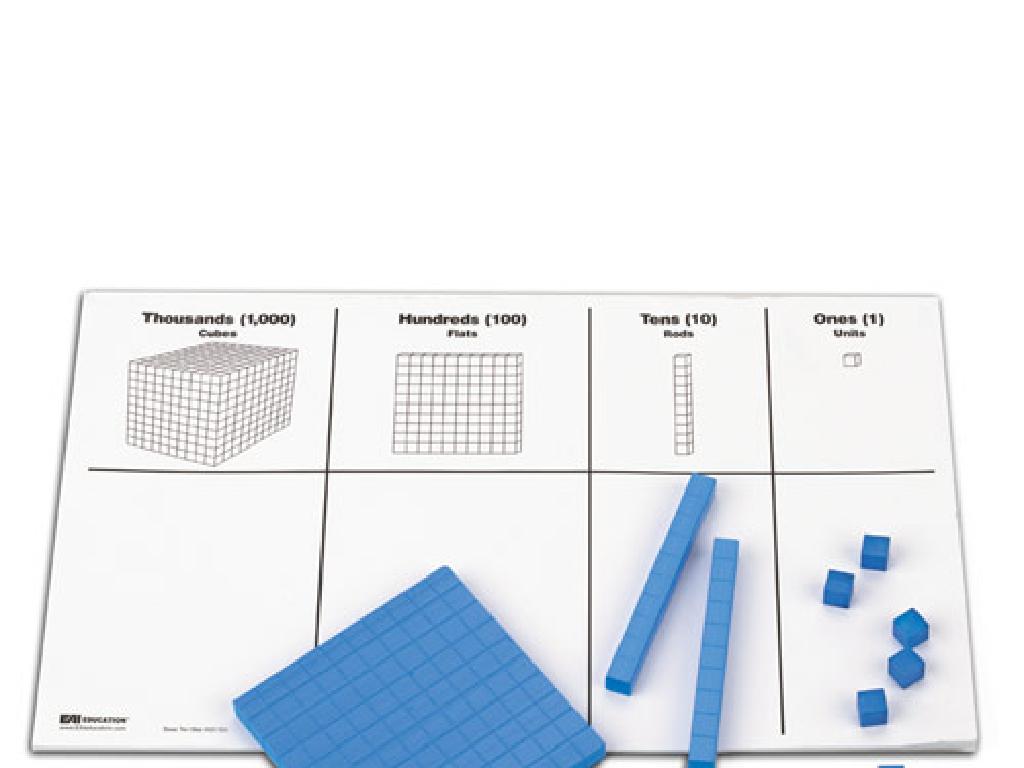The Greenhouse Effect
Subject: Science
Grade: Seventh grade
Topic: The Greenhouse Effect
Please LOG IN to download the presentation. Access is available to registered users only.
View More Content
Understanding the Greenhouse Effect
– Our planet’s temperature control
– What is the Greenhouse Effect?
– The process by which certain gases trap heat from the sun
– Significance of the Greenhouse Effect
– It keeps Earth warm enough to support life
– Impact on Earth’s climate
– Excessive greenhouse gases can lead to global warming
|
This slide introduces the concept of the Greenhouse Effect as Earth’s natural temperature control system. It’s crucial for students to understand that the Greenhouse Effect is a natural process that allows life to thrive by keeping the planet at a habitable temperature. However, it’s also important to discuss the balance required and how human activities have increased greenhouse gases, leading to an enhanced Greenhouse Effect and global warming. Encourage students to think about how changes in the Greenhouse Effect might impact weather patterns, wildlife, and global ecosystems.
Understanding the Greenhouse Effect
– Define the Greenhouse Effect
– The warming of Earth’s surface due to trapped heat
– Natural vs. Human-Enhanced
– Natural is essential for life; human-enhanced causes warming
– Greenhouse Gases: CO2 and Methane
– CO2 from burning fossil fuels; Methane from agriculture
– Impact on Earth’s Climate
|
The Greenhouse Effect is a natural process that warms the Earth’s surface. When the Sun’s energy reaches the Earth’s atmosphere, some of it is reflected back to space and the rest is absorbed and re-radiated by greenhouse gases. The absorbed energy warms the atmosphere and the surface of the Earth. This slide will explain the difference between the natural Greenhouse Effect, which makes life possible, and the human-enhanced effect, which results from increased emissions of greenhouse gases like carbon dioxide (CO2) and methane (CH4), leading to global warming and climate change. Emphasize the importance of understanding this process to appreciate the impact of human activities on our planet’s climate.
How Does the Greenhouse Effect Work?
– Sunlight interacts with Earth’s atmosphere
– Earth’s atmosphere allows sunlight to enter but traps heat
– The process: absorption and radiation
– Sunlight absorbed by Earth’s surface is radiated as heat
– Heat is trapped, warming the planet
– Greenhouse gases keep heat from escaping into space
– Similarity to a real greenhouse
– Glass walls of a greenhouse trap heat, warming plants inside
|
This slide explains the greenhouse effect by comparing it to a real greenhouse. Sunlight passes through Earth’s atmosphere and is absorbed by the surface, which then radiates it as heat. Greenhouse gases, like carbon dioxide and methane, trap some of this heat, preventing it from escaping into space, much like the glass walls of a greenhouse keep heat inside. This process is essential for life on Earth, as it keeps our planet warm enough to sustain life. However, an excess of greenhouse gases can lead to global warming. Encourage students to think about how this natural process is critical for our climate and what might happen if the balance is disrupted.
Greenhouse Gases and Their Sources
– Different types of greenhouse gases
– Common ones include CO2, CH4, N2O, and fluorinated gases
– Natural vs. human-made sources
– Natural sources: volcanoes, decomposition. Anthropogenic: industry, agriculture
– Carbon dioxide emissions from cars
– Cars burn fossil fuels, releasing CO2, a major greenhouse gas
– Methane release from agriculture
– Livestock digestion and manure management emit methane, a potent greenhouse gas
|
This slide aims to educate students on the various greenhouse gases and their origins. It’s crucial to differentiate between naturally occurring gases and those resulting from human activities, known as anthropogenic sources. Emphasize the role of carbon dioxide from vehicles and methane from agricultural practices as significant contributors to the greenhouse effect. Encourage students to think about how everyday activities, like transportation and food production, impact the environment. This understanding is key to fostering a sense of responsibility for the planet’s future and the importance of sustainable practices.
Effects of the Greenhouse Effect
– Global warming and climate change
– The Earth’s average temperature rises, leading to climate shifts.
– Altered weather and rising sea levels
– More extreme weather events and higher sea levels due to ice melt.
– Biodiversity loss
– Species extinction as habitats change or disappear.
– Case study: Melting polar ice caps
– Observing the rapid ice loss in the Arctic and Antarctic regions.
|
This slide aims to educate students on the consequences of the greenhouse effect, emphasizing its role in global warming and climate change. Highlight how the increase in Earth’s temperature can lead to significant changes in weather patterns, causing more frequent and severe weather events. Discuss the impact on sea levels as glaciers and polar ice caps melt, contributing to coastal erosion and habitat loss. Address the effect on biodiversity, with many species facing extinction due to rapidly changing environments. Use the case study of melting polar ice caps to provide a tangible example of the greenhouse effect’s impact, discussing the implications for global ecosystems and human populations. Encourage students to think critically about the relationship between human activities and these environmental changes.
Balancing the Greenhouse Effect
– Earth’s temperature balance is crucial
– A stable climate supports diverse life forms.
– Human activities impact greenhouse gases
– Fossil fuels, deforestation increase CO2 levels.
– Strategies to reduce carbon footprint
– Use renewable energy, recycle, plant trees.
– Role of individuals and communities
– Every action to reduce emissions counts.
|
This slide emphasizes the importance of the greenhouse effect in maintaining the Earth’s temperature for sustaining life. It highlights how human activities, such as burning fossil fuels and deforestation, contribute to the increase in greenhouse gases, leading to climate change. The slide also suggests ways individuals and communities can reduce their carbon footprint, such as using renewable energy sources, recycling, and planting trees. The notes should guide the teacher to discuss the balance needed to maintain a healthy greenhouse effect and the consequences of its disruption. Encourage students to think of daily habits that contribute to greenhouse gas emissions and how they can make changes to help the environment.
Class Activity: Simulating the Greenhouse Effect
– Understand the Greenhouse Effect
– Gather materials for the experiment
– You’ll need a clear plastic bottle, two thermometers, and a lamp
– Measure and record temperatures
– Place one thermometer inside and one outside the bottle under the lamp
– Observe the temperature changes
– Compare the temperatures after 10 minutes to see the effect of the bottle
|
This activity is designed to help students visualize the greenhouse effect. The clear plastic bottle represents the Earth’s atmosphere, and the lamp acts as the Sun. By measuring the temperature inside and outside the bottle, students can see how the bottle traps heat, similar to how greenhouse gases trap heat in the Earth’s atmosphere. Make sure students record the initial temperatures before turning on the lamp. After about 10 minutes, have them record the final temperatures. Discuss the results and relate them to how the greenhouse effect contributes to global warming. Possible variations of the activity could include using bottles of different colors or materials, comparing results with and without the lamp, or measuring over longer periods.
Wrapping Up: The Greenhouse Effect
– Recap the Greenhouse Effect
– Balance of Greenhouse Gases
– Too many gases can overheat Earth, too few can make it too cold.
– Importance for Earth’s Climate
– A stable climate allows ecosystems to thrive and supports life.
– Open Discussion
|
As we conclude, revisit the key points about the Greenhouse Effect, emphasizing its role in maintaining Earth’s temperature. Discuss the importance of balancing greenhouse gases, as an excess can lead to global warming, while a deficit could result in a cooler, less hospitable planet. Highlight how this balance is crucial for the health of our ecosystems and for life as we know it. Finally, open the floor for students to ask questions or share their thoughts, fostering a collaborative and inquisitive learning environment. Encourage them to think critically about how human activities impact this delicate balance and what actions we can take to preserve it.


/big_history_timeline.png)



